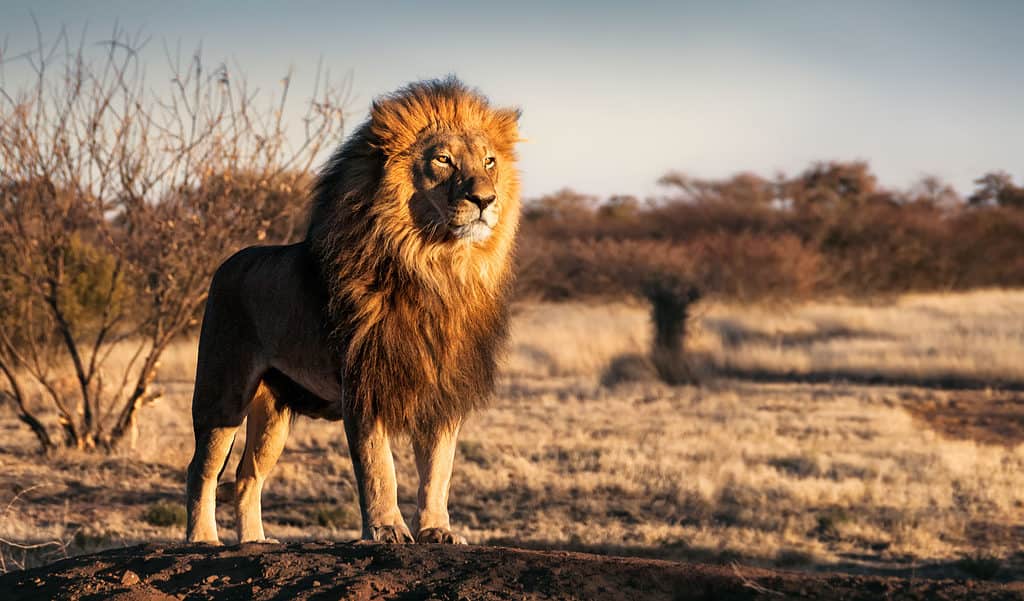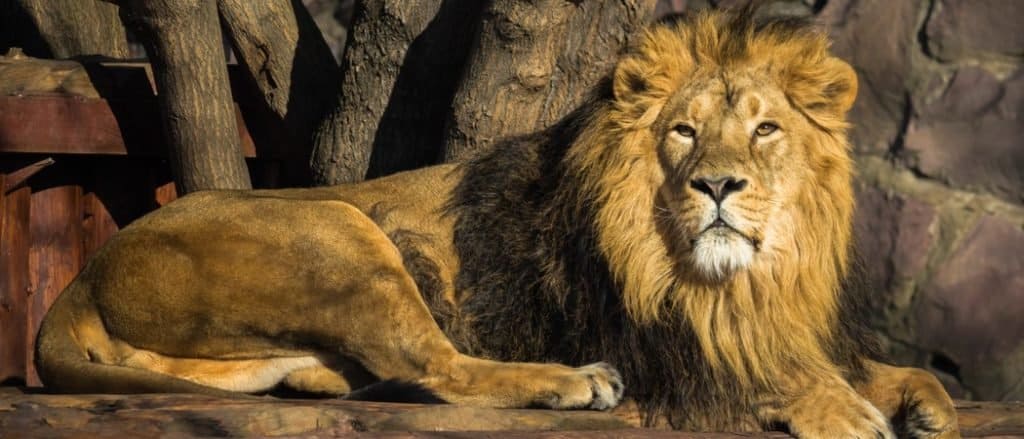The King of the Jungle is known for its majestic appearance and fierce hunting skills. But did you know that there are two different subspecies of lions? African lions and Asiatic lions may look similar, but there are several key differences between the two. From size and appearance to habitat, there’s a lot to learn about these two magnificent creatures. Get ready to enter the wild world of African lions vs. Asiatic lions and discover what makes each one unique.
African Lions

the African lion is truly one of the most fascinating and captivating animals on the planet.
©2021 Photography/Shutterstock.com
African lions, with their distinctive manes and powerful roar, have long captured the imagination of people all over the world. These magnificent big cats have roamed the African savannas for centuries and have come to symbolize strength, courage, and nobility.
But there’s much more to these incredible creatures than meets the eye. From their unique behaviors and social structures to their amazing hunting skills, the African lion is truly one of the most fascinating and captivating animals on the planet.
Asiatic Lions

The Asiatic lion, a unique species, can only be found in India.
©tgladkova/Shutterstock.com
Asiatic lions, with their regal demeanor and striking appearance, have long been revered as symbols of power and prestige. The Asiatic lion, a unique species, can only be found in India and is confined to the Gir National Park. Its rarity adds to its significance. These majestic big cats are different from their African counterparts, with a rich and fascinating history that spans centuries.
Despite facing challenges, the Asiatic lion has persevered and continues to attract interest through its distinctive traits and behaviors.
Key Differences Between African Lions and Asiatic Lions
Both Asiatic and African lions belong to the Panthera genus. However, they have distinct physical and behavioral differences that set them apart.
Size
The majestic Asiatic lions boast impressive sizes, with males weighing a sturdy 350-450 pounds and females weighing between 240-360 pounds. Standing at a shoulder height of 3.5-4 feet for males and 2.6-3.5 feet for females, these lions are truly a sight to behold. The average length of these lions is 5.57 feet to 8.2 feet for males and 4.6 to 5.74 feet for females. The largest recorded Asiatic lion measured an impressive 9.7 feet from nose to tail!
Though Asiatic lions are sizeable, African lions are even bigger. A male African lion can weigh up to 500 pounds, with females typically weighing around 345 pounds. The largest African lion ever recorded weighed a massive 800 pounds and measured an impressive 11 feet long.
Mane
When it comes to manes, there are three crucial aspects to keep in mind. Firstly, only male lions have them. Secondly, the growth of a mane begins at puberty. Lastly, manes can differ greatly in terms of color and size, both between different populations and within the same population.
A lion’s mane is its most recognizable feature, and the African and Asiatic lions have distinctively different manes. Asiatic lion manes are much sparser, darker, and less developed compared to the mane of African lions. It’s also usually shorter, leaving the Asiatic lion’s ears more visible.
African lions have a fuller and more prominent mane that covers their entire head and cascades down their shoulders. This luxurious mane is often more abundant, with a thicker and longer growth of hair. The color of African lion manes can range from light tawny to black. Interestingly, the mane’s thickness and color can indicate the health and strength of the male.
Despite these differences, both subspecies of lions use their manes for similar purposes: to attract potential mates and intimidate rivals.
Skin Folds
Impressive skin folds are another feature that sets Asiatic lions apart from their cousins. They have a striking longitudinal fold of skin under their bellies that runs the length of their bodies. It adds a level of dimension and texture to their truly captivating appearance.
On the other hand, African lions do not have skin folds. Instead, they have a smooth belly, contributing to their regal and powerful look.
Tail and Elbow Tufts
Asiatic lions have a more pronounced and flamboyant style of tail hair and elbow hair. These fluffs of hair are quite impressive! The tail tuft of an Asiatic lion is particularly striking, covering a large area and adding to the lion’s silhouette. The exact function of this tuft is still unknown.
On the other hand, African lions sport a more understated look. They have minimal tufts of hair on their elbows and tails, giving them a sleeker appearance.
Skull
Asiatic lions possess remarkable characteristics in their skull structure: bifurcated infraorbital foramina. These tiny openings in the skull ensure the smooth flow of blood and protect the nerves of the eyes.
African lions, in contrast, have only a single infraorbital foramen, distancing them from their Asiatic counterparts.
Habitat
Asiatic lions have an extremely restricted habitat. These lions can only be found in the Gir Forest National Park in the Indian state of Gujarat. This park is a protected area and is considered one of the last strongholds of the Asiatic lion. The park’s terrain is a mixture of dry deciduous forest and savanna grasslands, providing an ideal habitat for these big cats.
On the other hand, African lions are native to the savannas and grasslands of sub-Saharan Africa. They can be found in countries such as Tanzania, Kenya, and South Africa. These magnificent big cats thrive in open habitats with access to water, plenty of grasses, and bushes to hide in.
Prey
Asiatic lions have specific hunting styles due to their location. Since they can only be found in one national park, they have a smaller range of prey to choose from. The most common prey for Asiatic lions is chital deer, which weigh only about 110 pounds. Asiatic lions have also been known to eat wild boar and antelope.
African lions are known for their impressive hunting abilities and their tendency to go after larger prey. In their native habitats of sub-Saharan Africa, these big cats hunt and scavenge for wildebeests, zebras, and buffalos. The African lion’s prey ranges in weight from 600 to 2000 pounds, with buffalos being one of their favorite meals. Successfully catching these animals requires a highly coordinated hunt.
Prides
Asiatic lions have a distinct approach to socializing. As opposed to the pride structure of African lions, male Asiatic lions tend to move about in smaller, solitary pairs. They only join forces with females during mating or when working together to hunt larger prey. This independence allows them to claim larger territories and hunt without any limitations.
On the other hand, African lions have a unique social structure centered around the pride. A “pride” refers to a group of lions that live and hunt together, and it is typically composed of females. Prides are guarded by at least one male, who is responsible for safeguarding the females and fending off any potential dangers. This male plays a vital role in maintaining the pride’s stability and ensuring the survival of the cubs.
Population
Asiatic lions have a much smaller population than African lions, with only 523 individuals. This tiny population is found primarily in India’s Gir Forest. Their survival depends on protecting and conserving their remaining habitat. Asiatic lions face similar threats as African lions, including habitat loss, poaching for illegal trade, and human-wildlife conflict.
African lions are one of the world’s most iconic species, but their population has declined dramatically in recent years. It is estimated that only about 20,000 wild lions remain in Africa today, occupying a mere 5% of their former range.
Conservation Status
Asiatic lions are considered “endangered” with a stable population. This is due in part to conservation efforts in India. The government and local communities have worked together to protect their critical habitat, which has helped to stabilize the population.
Conversely, African lions are considered to be “vulnerable” by the International Union for Conservation of Nature (IUCN), with their population continuing to decline at an alarming rate.
The conservation status of African and Asiatic lions paints a worrying picture for the future of these magnificent cats.
Up Next
- Lion Predators: What Eats Lions?
- The Types of Lions: Every Lion Species & Lower Classification
- Baby Lions: 5 Lion Cub Pictures and 5 Facts
The photo featured at the top of this post is © Tony Campbell/Shutterstock.com
Thank you for reading! Have some feedback for us? Contact the AZ Animals editorial team.






